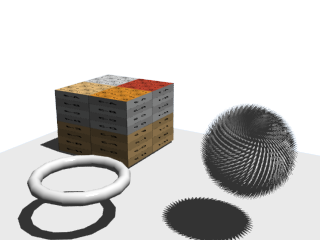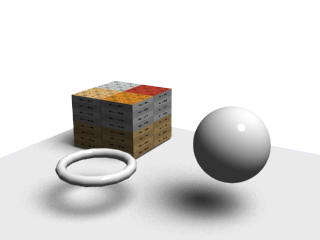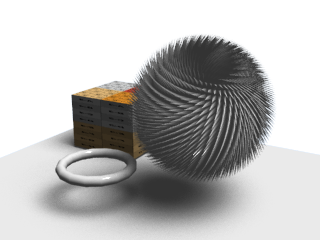Antialiasing Tips
General rules of thumb for selecting the type of antialiasing to use based on the scene and desired image are described below.
| Basic | Standard | Professional |
|---|---|---|
| O | O | O |
Recommended Antialiasing Types
When test-rendering a scene
Draft is the quickest method and is most appropriate when speed is desired over quality.
When the scene contains fine details such as sub-pixel lines

Adaptive Sampling is recommended.
- With Sampling Quality set low, increase Min Samples until lines are smooth.
- Increase Sampling Quality until the desired quality is achieved.
When blurring effects are used but the scene does not have complex detail

Adaptive Sampling is recommended.
When the scene contains things like area lights, increasing Min Samples will improve the quality of shadows but also dramatically increase rendering time.
A more efficient method is to keep Min Samples as low as possible while raising Ray Tracing Quality.
If the scene contains multiple area lights or lights with shadow softness and the lights cast shadows over a wide area, path tracing can be faster rendering method.
When blurring effects are used and the scene also has complex detail

Oversampling is recommended.
Set Ray Tracing Quality low and use Oversampling quality to improve the quality of shadows and fine detail.
Oversampling is inefficient with soft shadows, but there is no other easy way to reproduce complex detail other than increasing the number of samples.
Increasing Min Samples when using Adaptive Sampling can achieve the same effect, but to simply increase the number of samples oversampling is a simpler method and as a result is often faster.
If the scene contains two or more lights with soft shadows, such as area lights, path tracing will be faster (because path tracing is a simpler rendering method).
When test rendering scenes with coarse reflections, with path tracing intended for the final render
Adaptive Sampling is recommended.
Sampling filters share effects between Adaptive Sampling and path tracing, so the antialiasing results will be consistent.
Also, Adaptive Sampling's Sampling Quality multiplied by 50 equals path tracing's Ray Tracing Quality, so the necessary antialiasing quality can also be determined.
Types of Blurring Effects
The following chart lists the different types of blurring effects, which have a large impact on the speed of antialiasing when using ray tracing.
| Type | Name | Description |
|---|---|---|
| Light | Area Light | •Both illuminated areas and areas with shadows |
| Shadow Softness (Distant Lights, Object Lights) | •When shadow softness is non-zero •Both illuminated areas and areas with shadows |
|
| Volume Light | •Applies to the volume light | |
| Surface Attributes | Volume Rendering | •Objects with volume rendering applied |
| Subsurface Scattering | •Objects with subsurface scattering applied | |
| Path Tracing | (No Irradiance Caching) | •Applies to Whole Scene •Little effect when using irradiance caching |
| Photon Mapping | •Illuminated areas •Effect is greater in bright areas such as caustics |
Effect | Motion Blur | •Moving Objects •Effect is dependent on number of sub-frames |